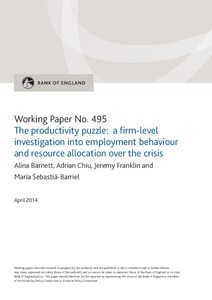The productivity puzzle: a firm-level investigation into employment behaviour and resource allocation over the crisis
"Labour productivity in the United Kingdom has been exceptionally weak since the 2007/08 financial crisis. This paper uses firm-level data from the Office for National Statistics Annual Business Survey and the Inter-Departmental Business Register to better understand the nature of this weakness...
| Main Authors: | , , |
|---|---|
| Institution: | ETUI-European Trade Union Institute |
| Format: | TEXT |
| Language: | English |
| Published: |
London
2014
Bank of England |
| Subjects: | |
| Online Access: | https://www.labourline.org/KENTIKA-19118868124919360409-The-productivity-puzzle-a-firm.htm |
| _version_ | 1771659898904379392 |
|---|---|
| author | Barnett, Alina Chiu, Adrian Sebastiá-Barriel, María |
| author_facet | Barnett, Alina Chiu, Adrian Sebastiá-Barriel, María |
| collection | Library items |
| description | "Labour productivity in the United Kingdom has been exceptionally weak since the 2007/08 financial crisis. This paper uses firm-level data from the Office for National Statistics Annual Business Survey and the Inter-Departmental Business Register to better understand the nature of this weakness. Overall, our findings are consistent with existing literature which finds that within-firm productivity growth tends to be procyclical and emphasises the importance of the reallocation of resources between firms and sectors for productivity growth. More specifically, we find that up until 2011 there was a doubling in the proportion of firms with shrinking output and flat employment. This suggests that firms were able to respond flexibly to weak demand conditions by retaining staff at the expense of measured productivity, suggestive of an opening up of spare capacity within firms. However, the strength of recent hiring behaviour since 2012 means that this is now likely to be less of a factor. The lack of labour shedding, together with a low firm exit rate, is also indicative of low levels of resource reallocation between firms and sectors. To assess the importance of this to aggregate productivity growth we apply the method used by Baily, Bartelsman and Haltiwanger. We find that reallocation between firms (in terms of both the movement of labour and firm entry and exit) contributed significantly to aggregate productivity growth before the crisis, but its contribution fell substantially after. In fact, around one third of the productivity slowdown after 2007 can be attributed to slower reallocation of resources. The extent to which reduced factor reallocation, and so the weakness in productivity growth, persists remains a key question for the economic outlook." |
| format | TEXT |
| geographic | United Kingdom |
| id | 19118868124919360409_fdad21839ce94c559f28a81002bce0d7 |
| institution | ETUI-European Trade Union Institute |
| is_hierarchy_id | 19118868124919360409_fdad21839ce94c559f28a81002bce0d7 |
| is_hierarchy_title | The productivity puzzle: a firm-level investigation into employment behaviour and resource allocation over the crisis |
| language | English |
| physical | 35 p. Digital |
| publishDate | 2014 |
| publisher | London Bank of England |
| spellingShingle | Barnett, Alina Chiu, Adrian Sebastiá-Barriel, María economic recession employment labour productivity The productivity puzzle: a firm-level investigation into employment behaviour and resource allocation over the crisis |
| thumbnail | https://www.labourline.org/Image_prev.jpg?Archive=109207992748 |
| title | The productivity puzzle: a firm-level investigation into employment behaviour and resource allocation over the crisis |
| topic | economic recession employment labour productivity |
| url | https://www.labourline.org/KENTIKA-19118868124919360409-The-productivity-puzzle-a-firm.htm |

